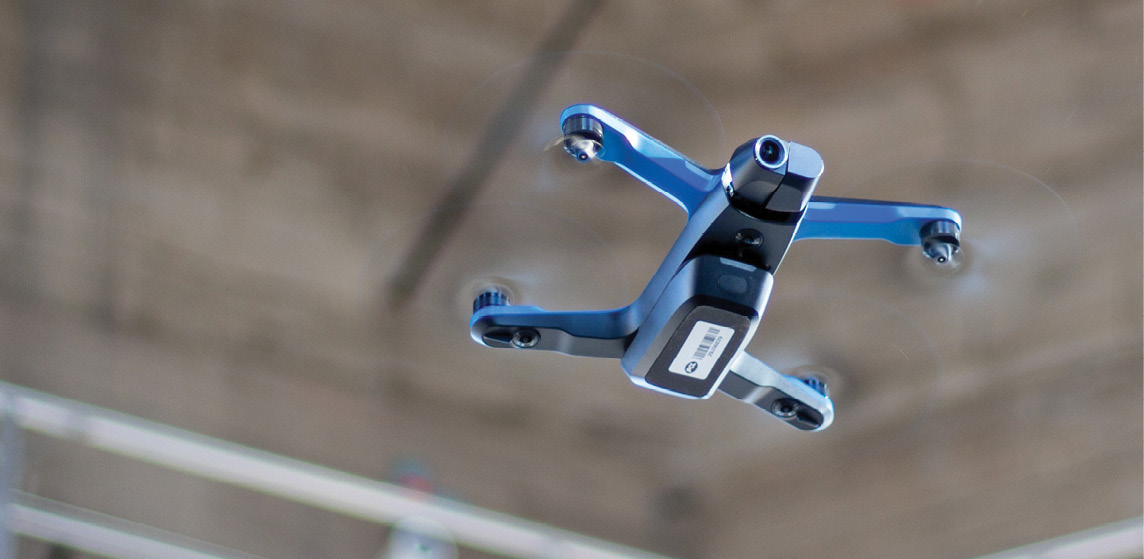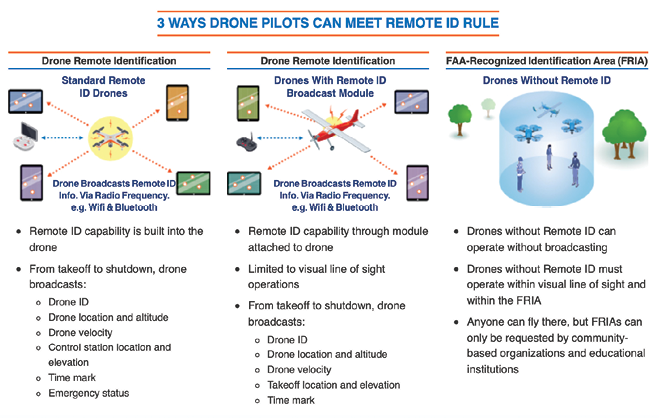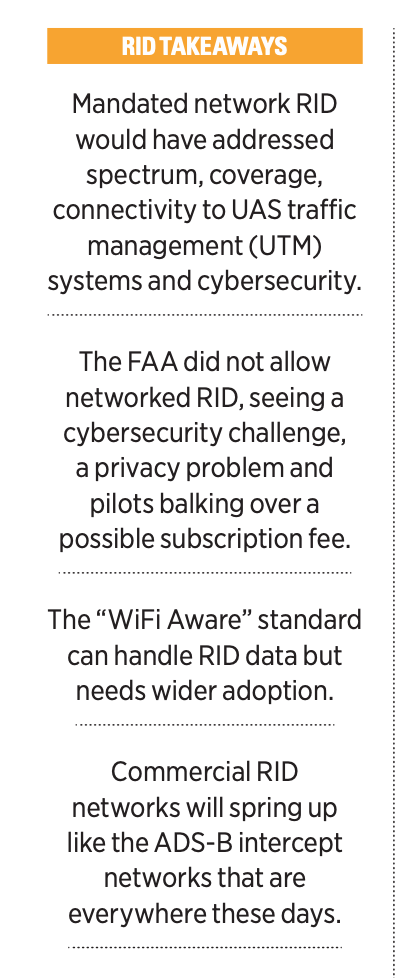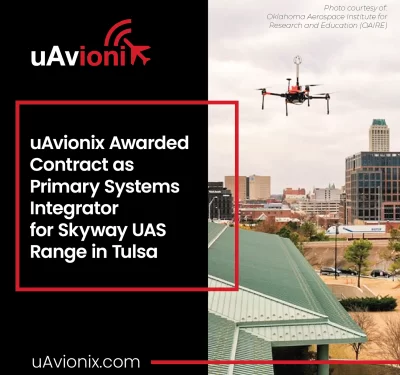
If Law-Tech Connect columnist Dawn Zoldi and I were successful in covering December’s breaking news about the FAA’s Remote ID (RID) rules, perhaps you can be enticed to read this article as a follow-up to that “3, 2, 1—Done! Remote ID Rule is Final” piece. Back then, we had just a few hours to review the details. Now, Dawn’s column explores the nuances of the regulations’ effects on various stakeholders. And I, with some hoped-for perspective, am tackling the pros and cons of the choices made by the FAA—and the one important remaining question…
How Will it Work?
Answering this question would have been easy if the FAA hadn’t ditched networked RID via LTE or 5G to only require broadcast RID. With networked RID, most drones would have connected to an RID UAS Service Supplier (USS)—probably via a wireless provider like Verizon’s Skyward—making RID coverage almost nationwide. Finding bad operators would have been a snap for local law enforcement; a subscription to an RID service and an app would have let them quickly find rogue drones and their ground station locations. Spectrum, coverage, connectivity to UAS traffic management (UTM) systems and cybersecurity would have all been addressed with network RID.
So why didn’t the FAA allow it? They had a bunch of objections to networked RID:
• It was a cybersecurity challenge (I sorta buy that; the wireless providers themselves have the best security in the business next to banks, but they won’t write all the apps working with their data, so those apps might be a risk.).
• It was a privacy problem (I sorta buy this; wireless carriers try to sell the data commercially.).
• Remote pilots would balk at paying for an RID subscription (I buy this one; the wireless carriers said they were not going to charge remote pilots to connect, but can you trust that?).
These qualms aside, the FAA was clear these rules were not a final “no” to networked RID and alluded they might be added to future rules.
Meanwhile, this leaves us today with only broadcast RID—something originally considered a backup to networked RID for places without cell phone coverage. Broadcast RID makes life easier for hobbyists and the drone manufacturers that cater to them, but much harder for commercial drones, law enforcement and national security users. Unlike network RID, broadcast RID does not have dedicated spectrum or a nationwide antenna network to relay RID data. Broadcast RID relies on yet-to-be-defined cybersecurity measures, and it makes usefulness and connectivity to UTM problematic.

Overcoming the Shortfalls
Spectrum and Format: The FAA was a bit vague on what spectrum band industry could use for broadcast RID, stating only that it must “use a non-proprietary broadcast specification and radio frequency spectrum…that is compatible with personal wireless devices.” This leaves a wide berth and includes spectrum and formats contained within Bluetooth and Wi-Fi formats for wireless devices. Herein starts the problems with using wireless phones for RID data.
Wi-Fi: The only RID broadcast Wi-Fi technique that works with Android wireless phones (not iPhones) is called “SSID stuffing.” Service Set Identifiers (SSIDs) are what Wi-Fi networks use to advertise their presence and invite users to log on. Each SSID can use up to 32 characters to pass information. The good news: every wireless phone can read SSIDs. The bad news: SSIDs can only pass 32 characters at a time, forcing broadcast RID users to broadcast the required message elements (serial number; session ID, control station or takeoff lat.; long.; altitude, air vehicle lat.; long.; altitude, time mark and emergency status indicator) sequentially over several SSID packets once per second.
Now, an app could stitch several SSID packets together to make a complete RID message. Unfortunately, SSID stuffing does not allow error correction; if the app you are using misses a packet, you miss that data. This is not a massive issue because broadcast RID updates every second; if you miss a packet, you just miss a second. But a bigger issue is that stuffing floods the spectrum with SSID messages, which is why I think spamming the spectrum will quickly become a nuisance to all Wi-Fi users operating near drones.
So can Wi-Fi work? The relatively new “Wi-Fi Aware” standard will work. Wi-Fi Aware was designed for the internet of things (IoT) to make it easier for non-communications devices (toasters, microwave ovens, etc.) to participate in Wi-Fi mesh networks. Wi-Fi Aware can handle the data throughput needed for RID and has forward error correction. That means it sends a good bit of additional encoded “correction data” in addition to the original data. It works if you’re missing a small bit of data, but it won’t work if you miss big chunks.
But the IoT industry wrote the Wi-Fi Aware standard as a “build it and they will come” effort, and so far, few have come to the party. Android added Wi-Fi Aware with Android 8, so many newer Android phones are compatible. Apple phones cannot currently receive Wi-Fi Aware, but there is hope they will adopt it because it is close to their AirDrop standard.
Bluetooth: Bluetooth shows more promise than Wi-Fi, but unfortunately it suffers from a similar drawback in wireless phone connectivity. Nearly all wireless phones can use Bluetooth 4 (BT 4), but BT 4 is short-ranged compared to BT 5 (about 1/4th the range). BT 4 must also broadcast RID data in small packets and, again, without error correction.
BT 5 solves all these problems with a much longer range, larger packets and forward error correction. Not all wireless phones can use BT 5, but a larger number of non-iPhones can. The tricky part: many phones claim to be BT 5-compatible, but they are only compatible with the higher data rate on BT 5 and not its long-range feature. The ASTM broadcast RID standard requires broadcast of both BT 4 and 5, so nearly all phones can receive short-range BT 4 broadcasts. Check this link for a list of phones compatible with one of the standards: github.com/opendroneid/receiver-android/blob/master/supported-smartphones.md (many thanks to Gabriel Cox from Intel, Chair of the ASTM Remote ID standard and founder of the Open Drone ID project that provided this study).
Antennas and Coverage: Broadcast RID does not come with an existing antenna relay system, as networked RID does. Unlike LTE or 5G, there is no nationwide Wi-Fi Aware or BT 5 network—nor will there be, seeing as how cellular signals travel 40 times further than Wi-Fi and Bluetooth. As discussed, unless law enforcement users switch to newer wireless phones, they won’t be able to access either viable broadcast RID format. BT 4 will work with nearly all wireless phones, but less reliably at much shorter distances (roughly 200-400 meters). That might be good enough for “cops on the beat” because they only need to receive a few RID messages to find a remote pilot but not good enough for users who need area surveillance and solid tracking for applications such as national security or UTM.
This means many RID users will need specially built receivers with high gain antennas to reliably receive broadcast RID for BT 5/Wi-Fi Aware or for area surveillance. Japan’s New Energy and Industrial Technology Development Organization, a government agency, recently conducted an RID test using BT 5 and saw an impressive maximum communication success rate of 95% at a horizontal distance of 300 meters to the target drone using specialized receivers. I foresee a big market for specialized broadcast RID receivers and relay networks for area surveillance. Ironically, I predict that by refusing to do networked RID the FAA will force industry and security users to build networked broadcast RID. Hmmm…
Cybersecurity: The wireless providers would have brought industry-leading cybersecurity to network RID. From the connection to the cell phone tower, to the relay, to processing centers, to the data processing centers themselves—America’s wireless carriers already have impressive security. None of that exists yet for broadcast RID. Constructing a secure system relies on FAA oversight of cybersecurity standards, currently not the agency’s strong suit. Mark my words—the commercial drone industry and national security users will require broadcast RID with network relay much like networked RID to operate at scale and be economically viable.
However, rather than dealing with a few highly experienced wireless carriers using time-proven security techniques, broadcast RID networks will evolve ad hoc amongst dozens of developers with varying degrees of cybersecurity experience. Keep in mind, both networked RID and broadcast RID with a relay network will rely on secure apps to function. None of those apps exist yet and neither do the specific cybersecurity measures needed to make them secure. The FAA will not be much help initially because it still sees itself as a safety agency, not a security agency. It’s only just getting its feet wet with cybersecurity because of its impact on safety. None of this is insurmountable but I predict quite the learning curve.
Connectivity to UTM: The commercial drone industry views UTM as the backbone for commercially viable drone operations. With broadcast-only RID, UTM users must rely on intercepting RID air to air to avoid collisions. This might work, but no one has thoroughly tested it and it might be a struggle getting the FAA to allow it. The Traffic Collision Avoidance System (TCAS), a similar concept, took seven years to approve. The UTM industry was much more comfortable with using networked RID to avoid collisions. Again, broadcast RID with a relay network would replicate this.
How it Could Work
Like everything in aviation, broadcast RID will rely on people, procedures and equipment. The FAA is aiming for two broad classes of remote pilots flying visual line of sight (VLOS) and beyond visual line of sight (BVLOS). VLOS remote pilots will not require additional training or certification outside of the Part 107 requirements, nor will they require additional navigation/RID equipment beyond the UAS RID rules. VLOS pilots will either fly without RID in FAA-recognized identification areas (FRIAs) or outside FRIAs with RID, but always within sight of their air vehicles. Hence, manned aircraft and BVLOS drones will either avoid well-marked FRIAs or count on VLOS remote pilots to avoid collisions with drones (is this really a good idea?). Air to air broadcast RID might decrease collision probability if it works. BVLOS remote pilots will need additional training and, probably, certified aircraft to fly.
Procedures will provide additional safety. BVLOS remote and manned pilots will avoid FRIAs (will FRIAs become de facto restricted airspace?) and exercise extra precautions when flying below 400 feet. BVLOS remote pilots will use procedures like instrument flight rules to file flight plans that ensure everyone knows where they will fly.
Equipment will be key for both individual and enterprise RID users. It will take a while before all wireless devices can access the two most viable non-proprietary broadcast specifications. Hence, sales of BT 5 and Wi-Fi Aware dongles for wireless phones and ground stations will soar with user markets, especially law enforcement. They will not be too expensive. ADS-B USB receivers cost about twenty bucks and there will be a bigger market for RID receivers. Remote ID receiver for manned and unmanned aircraft will become a thing if air to air RID intercept tests well.
As I have discussed repeatedly, even the best RID wireless individual receiver is no substitute for broadcast RID backed up with a relay network for area surveillance. FAA, large law enforcement organizations and national security users simply cannot rely on individual agents using wireless phones to monitor big areas like the National Capitol Region (NCR), Atlanta Hartsfield Airport or even Central Park in New York. These sort of users will rely on a mix of government RID relay networks like the FAA’s ADS-B backhaul network that allows the Traffic Information Service—Broadcast (TIS-B) to rebroadcast ADS-B tracks. I’ll wager that these RID receivers will be integrated into counter-UAS (C-UAS) systems once the feds sort out their C-UAS authorities and procedures. The FAA will pay for RID networks around airports but there will be a massive fight between multiple federal agencies over who pays for the rest. Can’t wait to see the battle unfold over funding the NCR in particular.
Commercial RID networks will spring up like the ADS-B intercept networks that are everywhere these days. Companies that already operate ADS-B relay networks (L3 Harris, FlightAware, Flightradar24), first responder networks (AT&T) and, yes, cell phone networks, will have an advantage because they have existing infrastructure for broadcast RID intercept. Law enforcement, commercial UAS operators and UTM USS will likely have to pay to connect.
The biggest question is cybersecurity and the RID rule does not talk much about it. Even though the FAA sees itself as a safety, not a security, agency I hope it now understands that cybersecurity equates to safety in an increasingly automated and unmanned aviation world. It will be difficult, but the FAA must figure out how to ensure security. I like the Department of Homeland Security’s concept of secure drone operators, in which vetted drone operators can access airspace normally restricted to drones—like allowing package delivery in the NCR if operators use approved token-based or blockchain ID schemes in addition to broadcast RID. I foresee a big market for secure RID equipment, software and services.
Broadcasting the Future
It will take time, but the nation will figure out how to use broadcast RID to make our skies safer and more secure. True, there are problems with both Wi-Fi and Bluetooth for broadcast RID, but both standards are well known to industry. We might not be able to use broadcast RID on many current wireless phones, but I have no doubt that industry ingenuity will solve this problem. ASSURE’s Mississippi State University (ASSURE is The Alliance for System Safety of UAS through Research Excellence) is already under contract with the FAA to objectively test RID means of compliance, so I am confident all this innovation will get a thorough and fair review before being released. Best of all, some of the drone world’s finest minds have already helped ASTM write standards for broadcast (and networked) RID that the country can implement quickly now that the rule is out.
All in all, it ain’t perfect but I am optimistic. Kinda. Sorta. For now.






